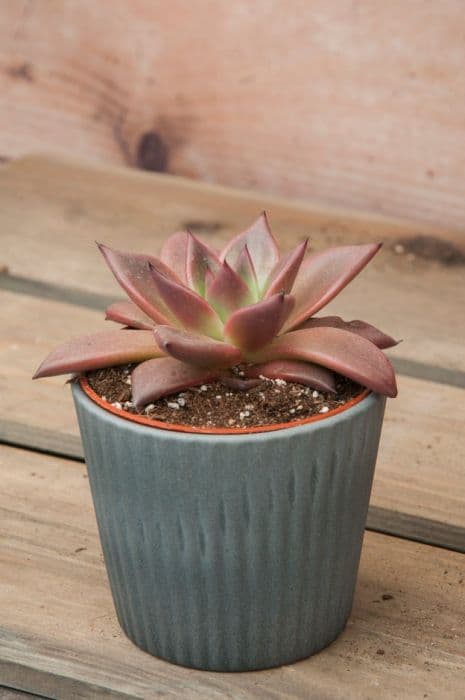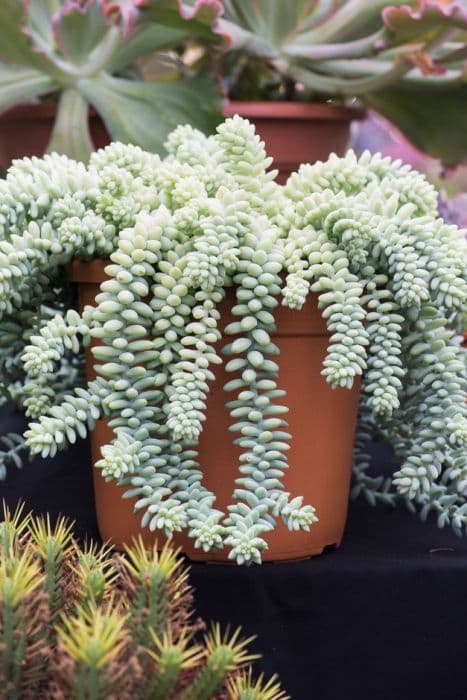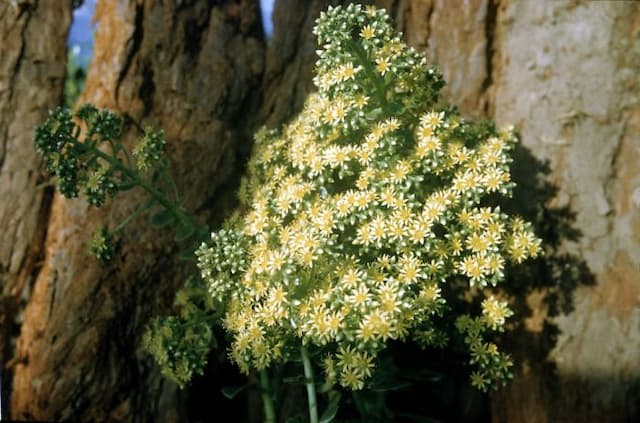Atlantis Stonecrop Sedum takesimense Atlantis = 'Nonsitnal' (v)
![Takeshima stonecrop [Atlantis]](/_next/image?url=https%3A%2F%2Fplants-admin.emdemapps.com%2Fimages%2Fplants%2F%2Fimages%2F604b5470cdde2.png&w=3840&q=75)
ABOUT
Sedum takesimense Atlantis, commonly known as Atlantis stonecrop, possesses a striking and decorative appearance that captures the eye in any garden setting. The leaves of Atlantis stonecrop are its most notable feature, with a creamy-yellow to white variegation on the margins, contrasting sharply with the blue-green color in the center. This variegation can create a shimmering effect when the plant is viewed from a distance. The leaves are fleshy and have a rounded, slightly spoon-shaped form, characteristic of many stonecrop varieties. They grow in a rosette pattern, forming small clusters that come together to create a textured mat over the ground. During the blooming period, Atlantis stonecrop produces flower clusters that stand above the foliage. The flowers tend to be a soft, pale pink to almost white hue, adding a subtle touch of color against the variegated leaves. These star-shaped blooms are small yet plentiful, creating a delicate and frothy look when in full flower. The overall impression of Atlantis stonecrop is one of a hardy, attractive groundcover that provides year-round interest with its ever-changing foliage and seasonal blooms. Its resilience and unique coloring make it a popular choice for adding contrast and color to rock gardens, borders, and containers.
About this plant
 Names
NamesFamily
Crassulaceae
Synonyms
Atlantis Stonecrop, Sedum 'Nonsitnal', Cream and Green Carpet Stonecrop
Common names
Sedum takesimense Atlantis = 'Nonsitnal' (v).
 Toxicity
ToxicityTo humans
Stonecrop is generally considered non-toxic to humans. However, ingesting any plant material can potentially cause mild gastrointestinal discomfort, though it is uncommon with Stonecrop. Always practice caution and keep plants out of the reach of small children who might inadvertently consume plant parts.
To pets
Stonecrop is also generally considered non-toxic to pets. If a pet ingests a small amount, it is unlikely to cause severe symptoms. However, gastrointestinal upset such as vomiting or diarrhea is always possible when animals consume plant matter that they are not accustomed to. As a precaution, it is still wise to prevent pets from ingesting this plant.
 Characteristics
CharacteristicsLife cycle
Perennials
Foliage type
Evergreen
Color of leaves
Variegated
Flower color
Yellow
Height
0.5 feet (15 cm)
Spread
1.5 feet (45 cm)
Plant type
Succulent
Hardiness zones
5
Native area
Asia
Benefits
 General Benefits
General Benefits- Drought Tolerance: Sedum takesimense Atlantis is highly tolerant to dry conditions, making it suitable for xeriscaping and water-wise gardens.
- Low Maintenance: It requires minimal care once established, thus reducing the need for frequent watering, fertilizing, or pruning.
- Attracts Pollinators: The flowers provide nectar and attract bees, butterflies, and other beneficial insects to the garden.
- Year-round Interest: Offers attractive foliage and a changing appearance throughout the seasons, with blooms in summer and interesting leaf textures.
- Erosion Control: The plant's dense growth habit helps stabilize soil and prevent erosion on slopes or banks.
- Adaptability: Thrives in a variety of soil types as long as they offer good drainage.
- Hardiness: It is cold-hardy, which makes it suitable for gardens in cooler climates.
- Visual Appeal: With its variegated foliage and bright flower color, it adds a striking visual element to rock gardens, borders, and containers.
- Propagation Ease: Can be easily propagated from cuttings, making it simple to expand your garden or share with others.
- Resilience: Resistant to pests and diseases, ensuring it remains healthy with minimal intervention.
 Medical Properties
Medical PropertiesThis plant is not used for medical purposes.
 Air-purifying Qualities
Air-purifying QualitiesThis plant is not specifically known for air purifying qualities.
 Other Uses
Other Uses- Sedum Atlantis is often used in living roofs or green roofs, where it helps to insulate buildings and extend the life of the roofing materials.
- The dense foliage and mat-forming habit of Sedum Atlantis make it ideal for erosion control on slopes and banks.
- As a drought-tolerant plant, it is used in xeriscaping to reduce the need for irrigation in dry climates.
- The plant's texture and colorful leaves can be used in art installations, adding a natural element to creative displays.
- Sedum Atlantis serves as a ground cover in fairy gardens, contributing to the miniature landscaping with its scale-appropriate foliage.
- It can be used in living walls or vertical gardens, both indoors and outdoors, to provide visual interest and greenery.
- In culinary applications, although not commonly eaten, the leaves may be used as a decorative edible garnish in small quantities for their crisp texture.
- The Sedum Atlantis is used in educational programs to teach children about plant biology, resilience, and growth habits.
- Crafters sometimes use the dried stems and flowers of Sedum Atlantis in wreaths and dried flower arrangements.
- Photographers utilize the attractive foliage and flowers of Sedum Atlantis as a backdrop or feature in close-up photography of insects and other small wildlife.
Interesting Facts
 Feng Shui
Feng ShuiThe Sedum Atlant is not used in Feng Shui practice.
 Zodiac Sign Compitability
Zodiac Sign CompitabilityThe Sedum Atlantis is not used in astrology practice.
 Plant Symbolism
Plant Symbolism- Innovation: The award-winning nature of Atlantis Sedum (Stonecrop) symbolizes human innovation, reflecting its unique features that garnered it the prestigious Plant of the Year award at the 2019 RHS Chelsea Flower Show.
- Resilience: Stonecrop is known for its tough, hardy nature, often growing in arid and rocky areas, which makes it a symbol for resilience and ability to survive and thrive in challenging conditions.
- Adaptability: As a plant that can adapt to a variety of conditions and is easy to care for, Stonecrop represents the ability to adjust and prosper in various environments.
- Peace and Tranquility: With its lush foliage and soothing appearance, Stonecrop is often associated with creating a sense of calm and serenity in gardens, symbolizing peace and tranquility.
- Longevity: Due to its perennial nature and longevity, Stonecrop symbolizes enduring and lasting elements in life, whether they are relationships, endeavors, or personal growth.
 Water
WaterThe Atlantis Stonecrop needs moderate watering, typically every 7-10 days, depending on the season and the climate it is in. During the growing season in spring and summer, it's important to water thoroughly when the top inch of soil feels dry to the touch; this may equate to approximately 1 gallon for a medium-sized outdoor plant every 1-2 weeks. Over the winter months, reduce watering to once a month or less, as the plant is dormant and uses less water. Avoid letting the plant sit in waterlogged soil as it is prone to root rot.
 Light
LightAtlantis Stonecrop thrives in full sun to partial shade. Ideally, it should receive at least 6 hours of direct sunlight each day. The perfect spot for this plant would be in a south-facing garden or near a window where it can bask in the morning sun, but it's also capable of growing in a slightly shaded area where the light is bright but indirect.
 Temperature
TemperatureAtlantis Stonecrop prefers a temperate climate and does well in temperatures between 60°F and 75°F. While it can withstand temperatures as low as 30°F, it should not be exposed to frost for prolonged periods. Generally, it's a hardy plant that can tolerate summer highs up to 90°F as long as it's not exposed to intense afternoon heat without relief.
 Pruning
PruningPrune Atlantis Stonecrop to remove any dead or damaged foliage and to maintain its compact shape. Pruning is best done in early spring or immediately after flowering. You can also deadhead spent flowers to encourage a second bloom. It generally requires minimal pruning, perhaps once annually, unless you are shaping the plant or controlling its spread.
 Cleaning
CleaningAs needed
 Soil
SoilThe best soil mix for Sedum Atlantis (Stonecrop) should be well-draining with a mix of peat, perlite, and sand or gravel. An ideal soil pH range is 6.0 to 7.5. It is important to avoid retaining too much moisture to prevent root rot.
 Repotting
RepottingSedum Atlantis (Stonecrop) generally does not require frequent repotting and can be done every 2-3 years, or when you notice that the plant has outgrown its pot. Make sure to use a well-draining soil when repotting.
 Humidity & Misting
Humidity & MistingSedum Atlantis (Stonecrop) is tolerant of a wide range of humidity levels. It prefers a low to average humidity environment and does well in the typical humidity found in most homes.
 Suitable locations
Suitable locationsIndoor
Place in bright light, water sparingly.
Outdoor
Full sun to partial shade, well-draining soil.
Hardiness zone
4-9 USDA
 Life cycle
Life cycleSedum takesimense Atlantis, commonly known as Stonecrop, begins its life cycle as a seed that germinates in moist, well-draining soil during spring. As seedlings emerge, they establish a root system and develop succulent leaves, forming a low-growing rosette characteristic of juvenile plants. The Stonecrop then enters a vegetative growth phase, spreading laterally and sometimes producing offsets to form a dense mat. During late spring to summer, it matures and produces clusters of small, star-shaped flowers on vertical stalks that attract pollinators. After flowering, seed heads may form, dispersing seeds for the next generation, while the parent plant typically remains evergreen or semi-evergreen, persisting through winter. In the following growing season, the plant continues its life cycle by further vegetative growth and, under the right conditions, another round of flowering and seed production.
 Propogation
PropogationPropogation time
Spring-Early Summer
Sedum takesimense 'Atlantis' is commonly propagated through leaf cuttings, and the best time to do so is during the plant's active growth period, which is typically in spring and early summer. The most popular method involves gently twisting a healthy leaf from the stem, making sure a small part of the stem is attached. This leaf is then laid on well-draining soil and lightly pressed down. Over the course of several weeks, with consistent but moderate watering, the leaf will develop roots and eventually a new rosette will begin to form. It is important to provide bright, indirect light and to avoid overwatering to prevent rot. Once the new plant has established a good root system, usually within a few months, it can be potted on its own.









